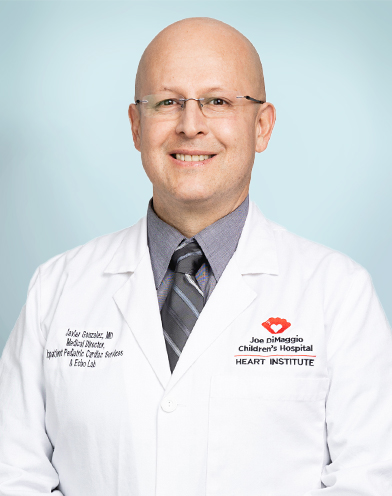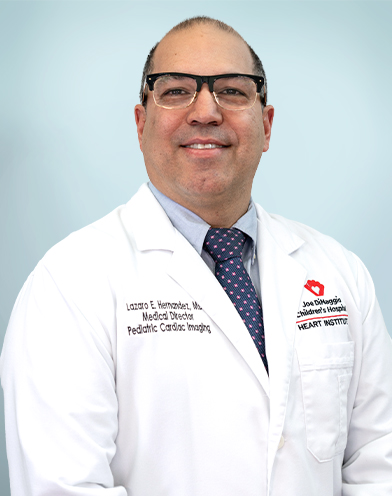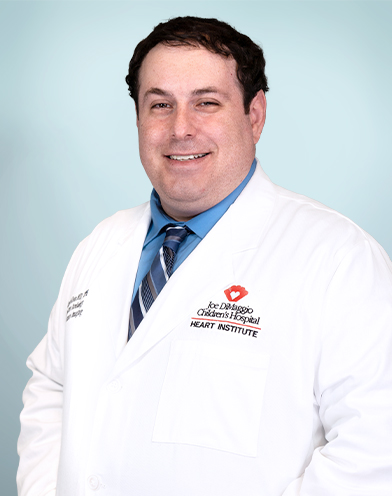Pediatric Heart Imaging
From routine echocardiograms to innovative MRIs, our pediatric cardiac imaging center uses new and noninvasive techniques that offer more accurate diagnoses.
From routine echocardiograms to innovative MRI techniques, the cardiac imaging center at Joe DiMaggio Children's Hospital Heart Institute uses cardiac imaging to heal hearts and save lives.
Our pediatric cardiac imaging program uses new, noninvasive techniques that offer more accurate diagnoses. Having a clear picture of what’s going on inside your child’s heart helps us diagnose and treat your child.
Call us for more information or to schedule an appointment
954-265-3437What Is Pediatric Cardiac Imaging?
Pediatric cardiac imaging helps us diagnose heart conditions in children. Imaging also guides cardiac surgeons and cardiologists during treatment. Finally, imaging is vital for your child’s recovery and follow-up because it helps us see how the heart and blood vessels have responded to treatment.
We use a variety of techniques and high-tech imaging equipment to see inside the heart’s structures. Many cardiac imaging tests are noninvasive, meaning there are no needles involved. For the imaging tests that do involve a needle or sedation, we will make sure your infant or child is comfortable and does not feel pain.
Why Choose the Joe DiMaggio Children’s Hospital Heart Cardiac Imaging Center?
We combine compassionate care with advanced technology to help diagnose and treat children of all ages. We are known for:
-
Leading the way in stress perfusion cardiac MRI: We are one of the first pediatric hospitals, and still one of the few, to offer stress perfusion cardiac magnetic resonance imaging (MRI) in children. This noninvasive test uses a drug to mimic the stress of exercise on a child’s heart while having a cardiac MRI. An MRI uses a magnet, radio waves and a computer to take pictures of the heart. This test:
- Helps children avoid cardiac catheterization or any other invasive diagnostic tests
- Allows us to see how blood flows to/from the heart muscle while at rest and during stressful conditions
- Has helped us to assess/evaluate patients and diagnose cases of hypertrophic cardiomyopathy
- Using advanced echocardiography: We use 3-D echocardiography to assess ventricular function (how well the heart pumps blood) during treatment and diagnosis. An echocardiogram (echo) is a noninvasive test that uses ultrasound waves to create images of the heart. A 3-D echo is superior to standard 2-D because it allows us to see the entire heart, so we can better prepare for a child’s heart surgery or cardiac ablation.
- Working as a team to care for children: Our team of cardiac imaging specialists works with every subspecialty within cardiology. Imaging provides the window to see what’s going on inside a child’s heart. Together, we help diagnose, treat and heal children – keeping families in the center at all times. Meet our team.
Noninvasive Pediatric Cardiac Imaging
Noninvasive means the imaging device stays outside the body. The most common noninvasive cardiac imaging tests include:
Cardiac MRI takes images of a patient's body using a magnet, radio waves and a computer. The MRI machine does not touch the child's body and does not use X-rays or radiation. To avoid exposing patients to radiation whenever possible, we use a cardiac MRI:
- When the echocardiogram is unclear or cannot give us enough diagnostic information
- To make a diagnosis and determine correct treatment
- For adult patients with congenital heart disease
- As part of surgical follow-up
Minimally Invasive Pediatric Cardiac Imaging
Minimally invasive means we introduce an imaging device inside the body. These tests include:
ICE is an emerging imaging technique that helps us get a clearer image of the inside of the heart. We use it during cardiac catheterization, often along with treatment for a congenital heart defect.
We use intravascular (inside the blood vessels) ultrasound during cardiac catheterization, a procedure that uses a needle stick in the leg to thread a tiny tube to the heart. The high-frequency sound waves of the ultrasound let us see inside the arteries.
Call us for more information or to schedule an appointment
954-265-3437



It matters to you. It matters to us.
Joe DiMaggio Children's Hospital Quality and Safety
See our hospital's patient satisfaction numbers, number of patients and more.
View Quality and SafetyYou have a Right to Know About Prices
We want to give you the information you need to make important healthcare decisions, including the costs of our services.
View PricingMyChart Portal
View test results, schedule follow-up appointments, request prescription refills and more.
Login or Sign-up to MyChart








